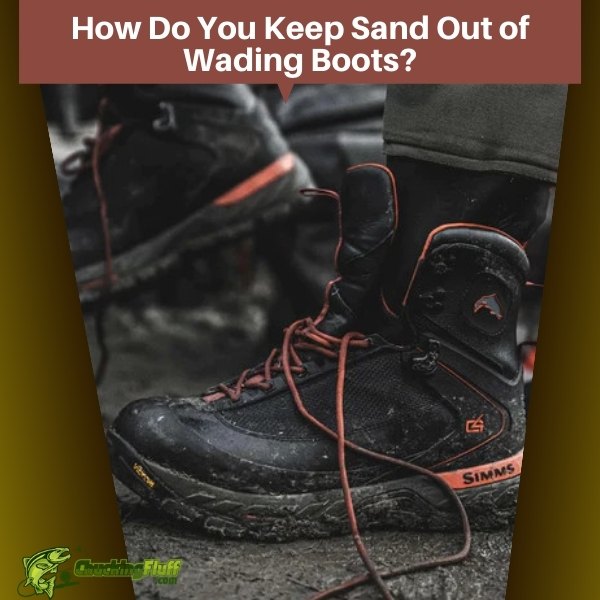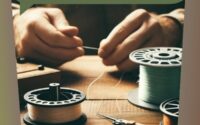| Disclosure: Just to be open and honest the buttons and links you click on in the website will in most cases take you to another website where you can purchase the products I am reviewing. As an Amazon Associate I earn from qualifying purchases. |
How Do You Keep Sand Out of Wading Boots? Comfort to Wade!

Different angling footwear give different feelings when sand gets into them but wading boots with gravel and these tiny earth pieces will leave you in so much discomfort, and bruises if you spend long hours in them.
Does that mean you’ll have to stop fishing?
Quick Post Navigation
No, so how do you Keep Sand out of Wading Boots?
The most important thing is having a pair of tight gravel guards to secure your footwear to your waders and prevent silt and sand from getting inside them.
There is a reason why these have to be tight and not loose as most people think they should be.
Other options to limit the entry of sand into your boots are by rolling down your socks to cover your wading boots or sealing the boot holes with epoxy.
You know, anglers will do anything workable for comfort, functionality, and performance hence the many DIY approaches.
How Do You Keep Sand Out of Wading Boots?
The only time you might escape this predicament is when fishing on flat non-sandy banks or from a vessel and you don’t have to move much in your wading boots.
Otherwise, if you are a regular angler who loves to trek to their sport, be on the flats in wading boots, or wade the streams and rivers, this is a challenge you have to constantly deal with.
Let’s learn how you can keep sand out of your wading boots.
Tight Gravel Guards for the Win
Gravel guards on wading boots should be tight to keep gravel, sand, and silt out of your footwear.
Loose fitting pairs allow the entry of these earth pieces and if standing in water, they can be pushed upwards by heavy currents.
Depending on the boots you have, these might come with lace hooks that will need fastening for more security.
Gravel guards that remain secured even when wading in heavier currents are the surest bet.
You can tuck in your lace hook inside the guards without attaching it to your boot.
Stretching your gravel guards further down towards your toe on the boot where the hook is on some pairs pulls and puts stress on several sections of the wader, the laces, and the footwear.
Avoid doing this to prolong the life of your gear.
Also, once bought, gravel guards can be tighter but they loosen up slightly over time for them to be easy to pull over the boot.
Bootfoot Waders are an Option
There are two main styles of waders anglers can choose from – Stockingfoot and boot foot waders.
Stockingfoot waders have neoprene booties attached to them at the feed section and will need a separate pair of wading boots for you to be ready for the sport.
Bootfoot waders come as chest waders with real wading boots attached to them in the feet area thus there isn’t a need to separately purchase others.
The latter are designed to prevent sand from getting into them but most people complain of them hurting and it is probably because of wrong sizing.
The boot foot design, though a sure bet at locking out sand, will need you to get into a gear store and make a proper fitting with some thick socks underneath to get the perfect size.
Otherwise, it makes no sense to get foot and toe sores from the same boots that should prevent similar effects after sand entry.
DIY Approaches
Fly fishers can be very experimental and if their ways work, they stick to them.
Bootfoot waders might not be your cuppa tea so Stockingfoot it is.
Thus, you’ll need to put in more effort besides having gravel guards to see most sand out of your gear.
Some anglers advise wearing a pair of long socks and rolling them to cover a larger part of your wading boots.
This has proven to work in most instances but you’ll be forced to bend from time to time to readjust them or often check if they are in place.
Or others opt to seal the drain holes on their footwear with epoxy which works too but will make your boots heavier when filled with water.
You’ll have to weigh the effects and see if the last option can work for you.
How Do You Keep Sand Out of Wading Boots? – FAQs
Check out some related questions and their answers and see how you can fish without the adverse effects of sand in your wading boots.
Q) What Are the Effects on Sand in Wading Boots?
A) Sand in wading boots gets uncomfortable and can lead to sore points if you don’t step aside to remove these tiny things.
Besides, they quickly damage your waders and wading boots which becomes expensive if you have to replace gear often.
Q) Can I Wear Gravel Guards without Lacing Up the Boots?
A) Some manufacturers state this in their product descriptions but for actual functionality, it is advisable to lace up your boots properly.
You want to seal all possible entries that could be used otherwise, silt and sand could ruin what was to be a successful fishing day.
Q) Does the Fit of Wading Boots Influence How Much Sand Gets in?
A) Yes, the fit is a primary concern and a pair that fits right without leaving extra space at the ankle reduces the amount of sand that gets into the boots.
Wide-ankle wading boots aren’t advisable if you are looking to lock out sand.
Wrap Up
How do you keep sand out of wading boots?
To lock sand out of your wading boots, get the right fit of footwear and avoid boots with wider entries since these leave space to let in silt and gravel.
Lace-up effectively and use tight gravel guards when wearing Stockingfoot waders.
Anglers with boot foot waders hardly suffer from this problem because of how their gear is designed.
However, getting the correct fit is a problem for most anglers looking for waders in this style.
Sometimes, the worst can hit the wall and the only solution is to invent working ways.
The rolling socks approach is a fantastic one until the angling inventors get on their experiments again.


